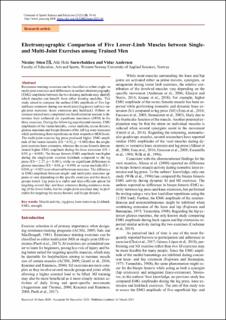| dc.contributor.author | Stien, Nicolay | |
| dc.contributor.author | Sæterbakken, Atle Hole | |
| dc.contributor.author | Andersen, Vidar | |
| dc.date.accessioned | 2021-08-30T11:48:31Z | |
| dc.date.available | 2021-08-30T11:48:31Z | |
| dc.date.created | 2021-07-08T11:44:17Z | |
| dc.date.issued | 2021 | |
| dc.identifier.citation | Stien, N., Saeterbakken, A. H., & Andersen, V. (2021). Electromyographic comparison of five lower-limb muscles between single- and multi-joint exercises among trained men. Journal of Sports Science and Medicine, 20(1), 56-61. | en_US |
| dc.identifier.issn | 1303-2968 | |
| dc.identifier.uri | https://hdl.handle.net/11250/2771769 | |
| dc.description.abstract | Resistance-training exercises can be classified as either single- or multi-joint exercises and differences in surface electromyography (EMG) amplitude between the two training methods may identify which muscles can benefit from either training modality. This study aimed to compare the surface EMG amplitude of five hip- and knee extensors during one multi-joint (leg press) and two single-joint exercises (knee extension and kickback). Fifteen resistance-trained men completed one familiarization session to determine their unilateral six repetitions maximum (6RM) in the three exercises. During the following experimental session, EMG amplitudes of the vastus lateralis, vastus medialis, rectus femoris, gluteus maximus and biceps femoris of the left leg were measured while performing three repetitions on their respective 6RM loads. The multi-joint exercise leg press produced higher EMG amplitude of the vastus lateralis (ES = 0.92, p = 0.003) than the single-joint exercise knee extension, whereas the rectus femoris demonstrated higher EMG amplitude during the knee extension (ES = 0.93, p = 0.005). The biceps femoris EMG amplitude was higher during the single-joint exercise kickback compared to the leg press (ES = 2.27, p < 0.001), while no significant differences in gluteus maximus (ES = 0.08, p = 0.898) or vastus medialis (ES = 0.056, p = 0.025 were observed between exercises. The difference in EMG amplitude between single- and multi-joint exercises appears to vary depending on the specific exercises and the muscle groups tested. Leg press is a viable and time-efficient option for targeting several hip- and knee extensors during resistance training of the lower limbs, but the single-joint exercises may be preferable for targeting the rectus femoris and biceps femoris. | en_US |
| dc.language.iso | eng | en_US |
| dc.publisher | University of Uludag | en_US |
| dc.rights | Attribution-NonCommercial-NoDerivatives 4.0 Internasjonal | * |
| dc.rights.uri | http://creativecommons.org/licenses/by-nc-nd/4.0/deed.no | * |
| dc.subject | muscle activity | en_US |
| dc.subject | leg press | en_US |
| dc.subject | knee extension | en_US |
| dc.subject | kickback | en_US |
| dc.subject | EMG | en_US |
| dc.subject | strength | en_US |
| dc.title | Electromyographic comparison of five lower-limb muscles between single- and multi-joint exercises among trained men | en_US |
| dc.type | Peer reviewed | en_US |
| dc.type | Journal article | en_US |
| dc.description.version | publishedVersion | en_US |
| dc.subject.nsi | VDP::Medisinske Fag: 700::Idrettsmedisinske fag: 850 | en_US |
| dc.source.pagenumber | 56-61 | en_US |
| dc.source.volume | 20 | en_US |
| dc.source.journal | Journal of Sports Science and Medicine | en_US |
| dc.source.issue | 1 | en_US |
| dc.identifier.doi | 10.52082/jssm.2021.56 | |
| dc.identifier.cristin | 1920987 | |
| cristin.ispublished | true | |
| cristin.fulltext | original | |
| cristin.qualitycode | 1 | |

